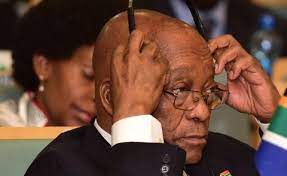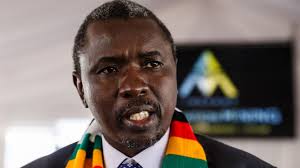Zuma was ‘determined’ to hand over Treasury to the Guptas, but resistance stalled its capture

Former President Jacob Zuma
Former President Jacob Zuma tried to hand over control of the Treasury to the Guptas, before his second term expired.
Zuma and the Guptas, however failed to capture Treasury because of the resistance by former ministers Gordhan and Nene and other department officials.
Zuma had made several attempts to appoint a finance minister who would advance the agenda of the Guptas.
Former president Jacob Zuma was “determined” to hand over control of National Treasury to the Guptas. However, the resistance by former finance ministers Pravin Gordhan, Nhlanhla Nene and former director general Lungisa Fuzile and other officials prevented Treasury from being captured, the State Capture report said.
The fourth part of the State Capture report was released on Friday. It deals with the attempted capture of National Treasury.

The report details how Zuma and the Guptas through several attempts tried to deploy people to Treasury to work things in their interests.… The fact that the Guptas and president Zuma failed to capture our National Treasury even after relentless attempts to do so over a long period of time is due largely to the ministers of finance that South Africa had during those years, namely Minister Nhlanhla Nene and Minister Pravin Gordhan, the men and women at National Treasury, including Mr Fuzile who was the Director-General and his team of senior officials who, in the interest of the country, put up serious resistance to president Zuma’s and the Guptas’ attempts. The country should be grateful to all of them.- State Capture report
After Nene was dismissed by Zuma on 9 December 2015, for not backing a nuclear deal, Treasury “nearly fell into the wrong hands”, the report read. Zuma had appointed Des Van Rooyen, who did not have a “good track record as a performer”, as finance minister. Financial markets reacted badly to the news of Nene’s dismissal and Van Rooyen’s appointment.
The report indicated that Van Rooyen had been placed in Saxonwold on at least seven occasions leading up to his appointment. The report suggests Van Rooyen was a Gupta appointment, he also brought on Gupta-appointed advisors to Treasury.
Citing Fuzile’s testimony, the report indicated that van Rooyen did not know Mahomed Bobat, whom he appointed advisor ahead of his swearing-in ceremony. Nor did van Rooyen know Ian Whitley, the man he would appoint as chief of staff.
The circumstances of their appointments were also questionable. For example, Van Rooyen appointed Whitley on the day he met him without having reviewed his CV or doing background checks. “No minister in his sound mind would appoint someone as his or her chief of staff on the first day he met him and without having checked his background,” the report read.
Van Rooyen also told the commission he was unaware that Bobat worked for Regiments – a Gupta-linked company – which suggested he did not review Bobat’s CV. “Mr Van Rooyen also did not do any background checks on Mr Bobat but offered him the position of advisor immediately,” the report read.
The commission concluded that van Rooyen had no choice in appointing his advisors as these were people the Guptas wanted him to appoint. “That is the only explanation that makes sense.”
According to the report, in the short time they were at Treasury, Bobat and Whitley sent confidential documents to the Guptas and their associates.I shudder to think what would have happened to this country if President Zuma was not forced to move Mr Des van Rooyen and his advisors out of the National Treasury and if Mr van Rooyen and his advisors had been allowed to continue in National Treasury.- State Capture report
Given public outcry over van Rooyen’s appointment and concerns that the destruction on markets would continue when they reopened on Monday, 14 December – Zuma was pressured to move him out of Treasury. Van Rooyen was moved to the Department of Cooperative Governance and Traditional Affairs and Zuma reluctantly appointed Gordhan as finance minister.
Gordhan, however faced opposition during his time at Treasury – these were seen as attempts to force him to resign so that Zuma could deploy a Gupta appointee.
Eventually, Gordhan and his deputy Mcebisi Jonas were sacked in a cabinet reshuffle in March 2017, on the basis that Zuma had an “intelligence report” that implicated them. According to testimony brought before the commission, the intelligence report the president relied on indicated that Gordhan and Jonas were planning an overseas trip to lobby international bodies against the South African government and economy. The credibility of the report has still not been determined.President Zuma dismissed Minister Gordhan because of his resistance to wrongdoing and because he wanted to appoint a minister of finance who carried the blessings of the Guptas.- State Capture report
According to the commission, Zuma needed a pretext to get Gordhan and Jonas out the way, so that someone could be appointed who would advance the Guptas’ agenda and capture Treasury. The person Zuma wanted to appoint was Brian Molefe, who at that stage was implicated in the public protector’s report on the capture of Eskom. The ANC Top 5, however, had blocked this appointment, and Zuma settled for Malusi Gigaba. In the past, Gigaba had been seen to cooperate with the Guptas and their agenda.
“The Guptas were very determined to capture National Treasury before president Zuma’s second term of office expired, and there was by then more or less just over a year left before the expiry of his second term. There was no time to waste.”
The report said that if Ramaphosa was not elected ANC president in December 2017, Gigaba could have possibly done more damage as finance minister.
In February 2018, Zuma was forced to resign. Ramaphosa was subsequently elected president of the country, and then appointed Nene as finance minister.






